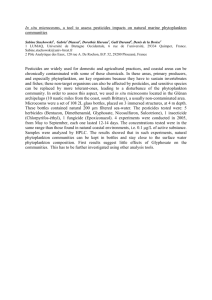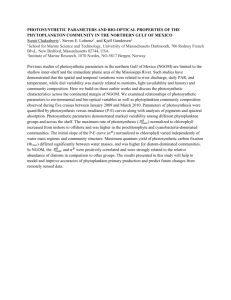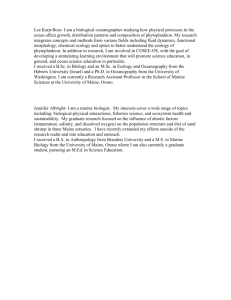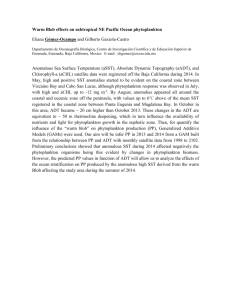Effect of a simulated oil spill on natural assemblages of marine
advertisement
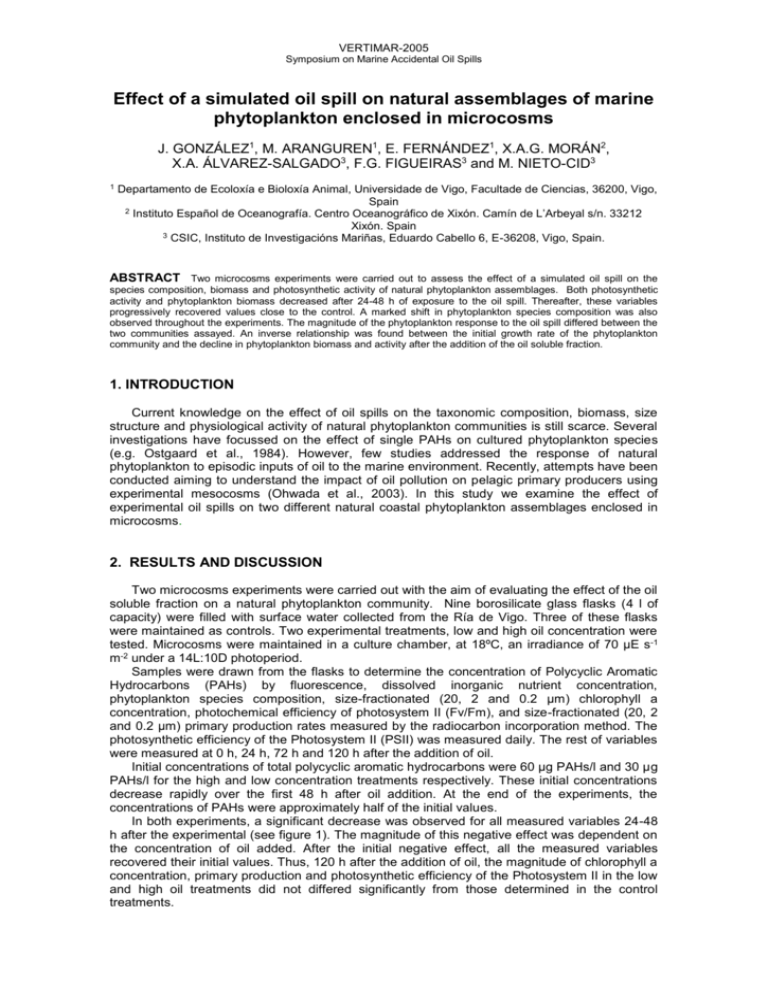
VERTIMAR-2005 Symposium on Marine Accidental Oil Spills Effect of a simulated oil spill on natural assemblages of marine phytoplankton enclosed in microcosms J. GONZÁLEZ1, M. ARANGUREN1, E. FERNÁNDEZ1, X.A.G. MORÁN2, X.A. ÁLVAREZ-SALGADO3, F.G. FIGUEIRAS3 and M. NIETO-CID3 1 Departamento de Ecoloxía e Bioloxía Animal, Universidade de Vigo, Facultade de Ciencias, 36200, Vigo, Spain 2 Instituto Español de Oceanografía. Centro Oceanográfico de Xixón. Camín de L’Arbeyal s/n. 33212 Xixón. Spain 3 CSIC, Instituto de Investigacións Mariñas, Eduardo Cabello 6, E-36208, Vigo, Spain. ABSTRACT Two microcosms experiments were carried out to assess the effect of a simulated oil spill on the species composition, biomass and photosynthetic activity of natural phytoplankton assemblages. Both photosynthetic activity and phytoplankton biomass decreased after 24-48 h of exposure to the oil spill. Thereafter, these variables progressively recovered values close to the control. A marked shift in phytoplankton species composition was also observed throughout the experiments. The magnitude of the phytoplankton response to the oil spill differed between the two communities assayed. An inverse relationship was found between the initial growth rate of the phytoplankton community and the decline in phytoplankton biomass and activity after the addition of the oil soluble fraction. 1. INTRODUCTION Current knowledge on the effect of oil spills on the taxonomic composition, biomass, size structure and physiological activity of natural phytoplankton communities is still scarce. Several investigations have focussed on the effect of single PAHs on cultured phytoplankton species (e.g. Ostgaard et al., 1984). However, few studies addressed the response of natural phytoplankton to episodic inputs of oil to the marine environment. Recently, attempts have been conducted aiming to understand the impact of oil pollution on pelagic primary producers using experimental mesocosms (Ohwada et al., 2003). In this study we examine the effect of experimental oil spills on two different natural coastal phytoplankton assemblages enclosed in microcosms. 2. RESULTS AND DISCUSSION Two microcosms experiments were carried out with the aim of evaluating the effect of the oil soluble fraction on a natural phytoplankton community. Nine borosilicate glass flasks (4 l of capacity) were filled with surface water collected from the Ría de Vigo. Three of these flasks were maintained as controls. Two experimental treatments, low and high oil concentration were tested. Microcosms were maintained in a culture chamber, at 18ºC, an irradiance of 70 µE s-1 m-2 under a 14L:10D photoperiod. Samples were drawn from the flasks to determine the concentration of Polycyclic Aromatic Hydrocarbons (PAHs) by fluorescence, dissolved inorganic nutrient concentration, phytoplankton species composition, size-fractionated (20, 2 and 0.2 µm) chlorophyll a concentration, photochemical efficiency of photosystem II (Fv/Fm), and size-fractionated (20, 2 and 0.2 µm) primary production rates measured by the radiocarbon incorporation method. The photosynthetic efficiency of the Photosystem II (PSII) was measured daily. The rest of variables were measured at 0 h, 24 h, 72 h and 120 h after the addition of oil. Initial concentrations of total polycyclic aromatic hydrocarbons were 60 µg PAHs/l and 30 µg PAHs/l for the high and low concentration treatments respectively. These initial concentrations decrease rapidly over the first 48 h after oil addition. At the end of the experiments, the concentrations of PAHs were approximately half of the initial values. In both experiments, a significant decrease was observed for all measured variables 24-48 h after the experimental (see figure 1). The magnitude of this negative effect was dependent on the concentration of oil added. After the initial negative effect, all the measured variables recovered their initial values. Thus, 120 h after the addition of oil, the magnitude of chlorophyll a concentration, primary production and photosynthetic efficiency of the Photosystem II in the low and high oil treatments did not differed significantly from those determined in the control treatments. VERTIMAR-2005 Chl a (µg/l) Symposium on Marine Accidental Oil Spills 1.80 1.60 1.40 1.20 1.00 0.80 0.60 0.40 0.20 0.00 Experiment I 0h 24 h 72 h 120 h 72 h 120 h Time 7.00 Chl a (µg/l) 6.00 Experiment II 5.00 4.00 3.00 2.00 1.00 0.00 0h 24 h Time Figure 1: Temporal evolution of chlorophyll a concentration in both experiments. White bars represent chlorophyll a concentration at control microcosms, light grey at low oil concentration microcosms and dark grey at high oil concentration microcosms. Both phytoplankton size structure and picoplankton and microplankton taxonomic composition changed dramatically at microcosms where oil was added. REFERENCES Ohwada, K., Nishimura, M., Wada, M., Nomura, H., Shibata, A., Okamoto, K., Toyoda, K., Yoshida, A., Takada, H., Yamada, M. (2003) Study of the effect of water-soluble fractions of heavy-oil on coastal marine organisms using enclosed ecosystems, mesocosms. Marine Pollution Bulletin 47:78-84. Ostgaard, K., Eide, I., Jensen, A. Exposure of phytoplankton to Ekofisk crude oil. (1984) Marine Environmental Research 11:183-200.
